| Home Eclipse Home Solar Eclipse 1999 2001 2002 2005 2008 2012 | Site Map |
Total Solar Eclipse from the Horombe Plateau, MadagascarJune 21st, 2001 |
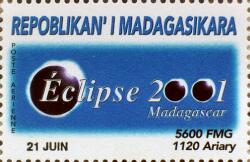
|
|
In June 2001, 18 Danes travelled around Madagascar on a trip arranged by Travel life. One of the goals of the trip was seeing the total solar eclipse on June 21st. Only my wife Birgit and I had witnessed a total solar eclipse before, in Hungary in 1999.
We arrived the evening before Eclipse Day to an unfinished camping site on the outskirts of Ranohira - a small village close to the Isalo mountains. There was a loudly discussion. The workers were afraid of the eclipse and wanted to go home, but the owner of the campsite refused to pay them before the building was finished.
The trip leaders had decided that we should view the eclipse outside Ranohira, partly to get away from the Isalo mountains, partly to get close to the center line. We chose a hill 23 km north-east of Ranohira from which we had a magnificent view over the Horombe Plateau.
We arrived about 45 minutes before first contact. A small group of Frenchmen had lined up and soon after more Frenchmen, some Americans, and some Malagasy people came to the hill.
We missed first contact because of a cloud. Contrary to our expectations the sky was covered with clouds. At this time of the year, the winds normally come from the Indian Ocean leaving their moisture on the mountains along the east coast of Madagascar. But that day the wind came from the west - from the Mozambique Channel. Why specifically on E-day?
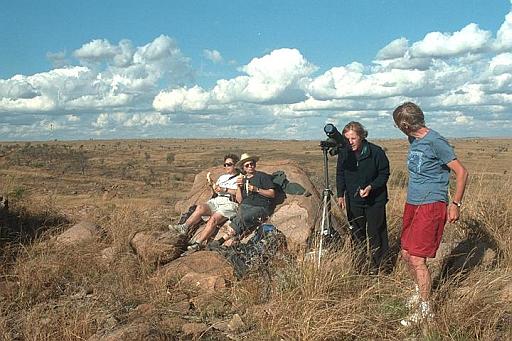 On the "Eclipse Hill".
On the "Eclipse Hill".
Sunspot watching during the initial partial phase.
Photo: Stig Linander.
Fortunately, most of the clouds disappeared during the initial partial phase. Only one huge cloud coming from the west threatened our view. But we were lucky, it just didn't arrive till totality. They weren't that lucky in Ranohira. Shortly before second contact we could see a long cortege of cars leaving Ranohira in a desperate attempt to escape the cloud.
Due to the low altitude of the Sun - only about 10° - we couldn't see the approaching shadow. Suddenly, the thin sickle of the Sun turned into a diamond ring with a dazzling clear diamond. Darkness didn't came as suddenly as we had experienced in Hungary, but gradually as the diamond faded away. It's difficult to estimate time during a total solar eclipse, but I felt it like 5-10 seconds before the diamond finally disappeared. As I remember the 1999 eclipse, the diamonds lasted only 1-2 seconds and they didn't decrease/increase in brightness.
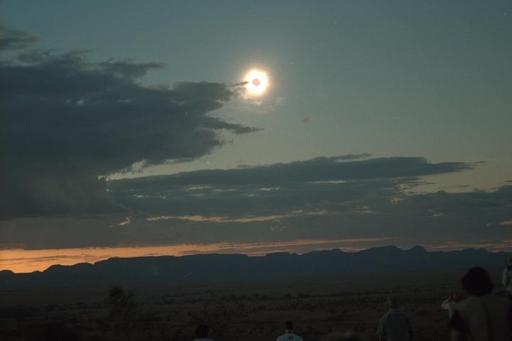
|
Totality, the notorious "Ranohira cloud", and the Isalo mountains. There's a keen distinction between success and failure. We were lucky, very lucky! The photo shows very well how bright the sky was during totality. However, with the naked eye, the corona wasn't that large. The photo is taken shortly before third contact. That's the reason for the bright "sunrise glow" in the horizon. Photo: Stig Linander. |
The sky was much brighter than in Hungary, and that was probably the reason why only the inner corona was visible naked eye. I remembered my binoculars, but I had them mislayed just before second contact and in the darkness I couldn't find them. I got a slight attack of panic, in Hungary I forgot to use the binoculars, and here I couldn't find them! I don't remember exactly what I said, but apparently something understandable: immediately a pair of binoculars were handed over to me, so that I and Signe (our daughter) could get a view. Thanks, Leif!
And there was the corona.
How beautiful it is with its petal structure!
That was a little bit difficult to see in Hungary due to a thin layer of
fleecy clouds.
There were quite a few prominences. At least three large ones - the brightest in "two o'clock position".
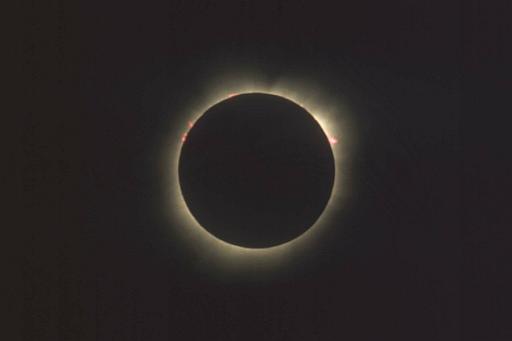 The inner corona and prominences.
The inner corona and prominences.
Photo: Leif Schack-Nielsen. Copyright.
And before you expect - just as in Hungary - the diamond ring reappears. It brightened slowly and stood dazzling clear in the sky for several seconds before the intense light from the Sun finally broke through. Just like the first diamond ring played backwards.
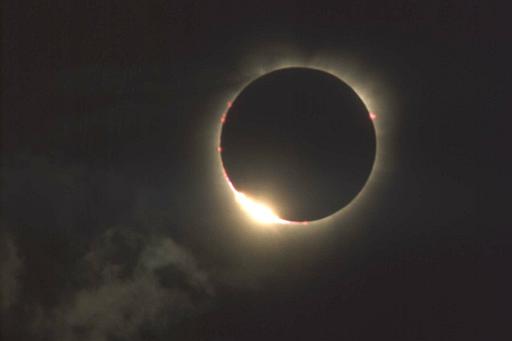 The diamond ring at third contact. The "Ranohira cloud" is
illuminated by the diamond.
The diamond ring at third contact. The "Ranohira cloud" is
illuminated by the diamond.
Photo: Leif Schack-Nielsen. Copyright.
I turned around trying to see the shadow disappearing over the plateau, but I saw nothing.
The show was over - at least the two and a half minutes that were the
main reason why we had travelled that long.
Everyone on the hill was enthusiastic.
The Frenchmen opened a bottle of champagne.
We celebrated the experience with "Gammel Dansk".
Someone let off fireworks.
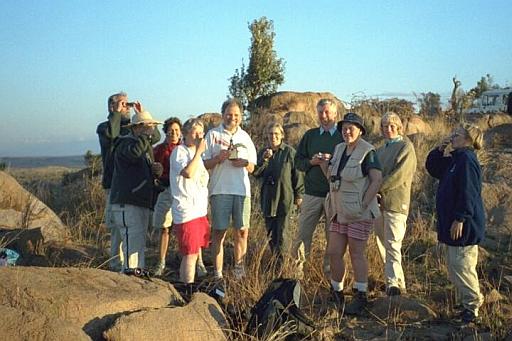 After totality - celebrating the experience with "Gammel
Dansk".
After totality - celebrating the experience with "Gammel
Dansk".
No clouds behind us!
Photo: Signe Linander.
We stayed on the hill almost until sunset. We talked about our experiences of the eclipse and: "When is the next eclipse?".
And then all the things I forgot - just as in Hungary. I forgot to look for shadow bands. Birgit remembered but she didn't see any.
We returned to Ranohira - transformed into a cauldron of chaos. We saw a couple of Dutchmen who had painted the outline of a cloud on their eclipse T-shirts. An original idea I'll remember the day I'm clouded out myself.
A great experience.
But very different from our experience in Hungary.
Madagascar is a marvellous experience. It has everything from rain
forests to sub deserts, from sandy beaches to impressive mountains. The
Malagasy people are friendly and hospitable, everywhere you are met with
a smile and with the childrens "Vazaha". The flora and the
fauna are unique with more than 75% of the species endemic.
Birds
are more mobile than most other animals, still more than half of the
breeding species are found nowhere else on Earth.
I can only recommend visiting Madagascar.
Text: Stig Linander, created: 2001-07-03, last revised: 2008-08-19